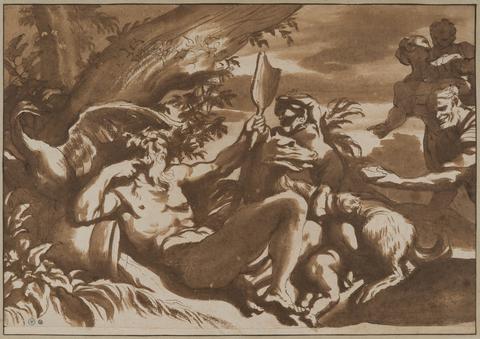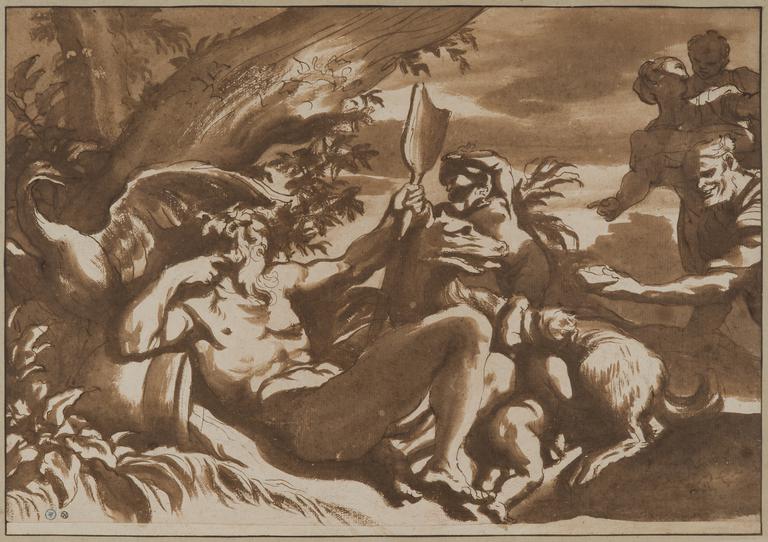
La Découverte de Romulus et Rémus
Domenico Piola (1627 Gènes - 1703 Gènes)
1680 (vers)
Plume et encre brune sur papier, lavis brun sur esquisse à la pierre noire ; 28,5 x 42 cm
Provenance :
Alliance des Arts (marque de collection Lugt 61 en bas à gauche) ; Charles Molinier (marque de collection Lugt 2917 en bas à gauche).
Ce dessin de relativement grand format, d'une extraordinaire vigueur, sculptural (le dieu fluvial) et fluide (la végétation), est typique de Domenico Piola, qui (avec son gendre Gregorio de Ferrari) domina la peinture génoise de la deuxième moitié du 17ème siècle ; typique aussi de l'art baroque, en ce qu'il privilégie l'effet d'ensemble, le mouvement, le contraste.
D'abord il étonne, ensuite on le comprend : il représente l'origine de Rome. Amulius, roi usurpateur, donne l'ordre de noyer les jumeaux Romulus et Rémus dans le lit du fleuve, mais ils survivent sur ses berges. Une louve les y trouve, à l'ombre d'un figuier, et les y allaite. Un pivert, selon Plutarque (Tite-Live n'en parle pas), veille également sur eux. L'artiste prend la liberté d'en faire une oie, préfigurant le rôle que jouera cet animal dans l'histoire de Rome en sauvant le Capitole d'un assaut des Gaulois.
L'instant représenté est celui où le berger Faustulus découvre les jumeaux. L'un d'eux tète encore. L'autre, par une invention merveilleuse de l'artiste, qui en fait en quelque sorte une figure du spectateur, lève le bras pour se protéger du soleil et du vent, comme du mouvement qui agite la scène et du contraste d'ombre et de lumière qui la structure. En le comparant par exemple à une Bacchanale de putti de l'Accademia ligustica di Belle Arti, à Gênes, on peut dater ce dessin de la décennie 1670-1680. C'était également la datation retenue par le galerie Marty de Cambiaire pour un dessin de format et de technique très comparable acquis par la National Gallery de Washington qui le date désormais de la décennie 1650-1660...
Parmi les précédents propriétaires de ce dessin, repérables à leurs cachets de collections, on trouve un prototype, en quelque sorte, de la collection Le Polyptyque : l'Alliance des Arts, « composé de bibliographes, d'artistes et de capitalistes (...) ayant pour but d'améliorer et faciliter les transactions commerciales et autres, concernant principalement les livres et les tableaux (...) en entourant la vente de garanties morales et artistiques » (Frits Lugt, les Marques de collections de dessins et d'estampes, en ligne). Créée en 1842, elle eut pour directeur Théophile Thoré, le « redécouvreur » de Vermeer. On trouve ensuite Charles Molinier, professeur d'histoire de l'art à Toulouse et grand collectionneur, particulièrement de dessins de l'école italienne du 16ème au 18ème siècles, actif de 1875 à 1910.
